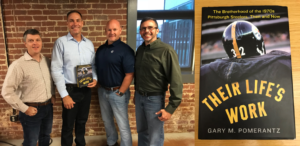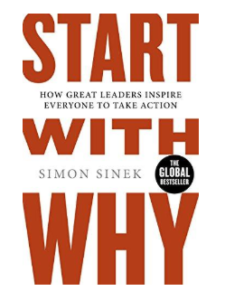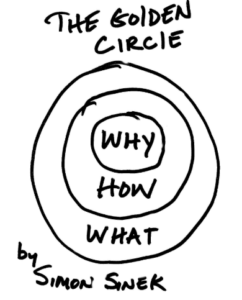
As many of you know, I am a football fan, more specifically, a Pittsburgh Steelers fan. And by football, I mean American Football played in the National Football League (NFL), not what Americans call soccer. Although I love “futbol” also!
In fact, it’s one of the first things people learn about me when they meet me. Since I am not from Pittsburgh though, people often ask:
“Why the Steelers”?
For one thing, they were the best team in the 1970’s when I was a child. Witnessing the Steelers win an incredible 4 Super Bowls in a 6 year span amazed and inspired me. It made me proud to be a fan and influenced how I wanted to be seen and some of my anchors (values) in life. In fact, I wore my Steelers jersey in every school picture (yes, that’s really me!)! As I got older and played sports, I always wondered: “What mindset would a team need to have to win so many championships in such a short amount of time?” This question and importance of mindset stuck with me throughout my life. Lastly, the “”Steelers” name was voted on and chosen by the local community to represent strength and the city’s main source of employment… the Steel industry. This created a connection and love between the people of Pittsburgh and the Steelers that is second to none in the NFL. Each year, my family and I attend a home game to experience this phenomenon. I have bled black and yellow ever since.
Recently, I had another opportunity to share my love for the Steelers (among others things) but this time as a guest speaker at a GE Training course in Roanoke, Virginia. Now to be clear, the focus of my presentation wasn’t about the Steelers, but rather the power of being authentic, embracing your journey and how the coaching mindset has changed my life or as the class later described it: “My Life Pivot”.
When I hear the word “pivot”, I always think of the years playing basketball in high school and how pivot meant to keep one foot stationary or “anchored” as you move the other foot legally to get a better view of the basket, the opponent or the court. This makes it easier to decide whether to dribble, pass or shoot, ensuring the anchored foot isn’t moved to avoid what’s called “traveling”. To me, this became symbolic of life and how our ability to clearly see and consider other options is greatly improved once we are “anchored” in who we really are, the beliefs we have and the life we are meant to live.
So I began my presentation with just that: a slide “About Me”. Instead of explaining the business I am from, my title, years at GE, and my job responsibilities, I shared things that reflect my values, my character and my passions…the things that “anchor me” from drifting away from my purpose in life:

- My Marriage: 22 Years to the most incredible woman in the world
- Family: Blessed with 2 amazing kids
- My Hometown: Milford NY, Population 3,000 and 1 stop light. Graduated 3rd in my High School class of 35
- My Heroes: My Mom and Jesus
- My Favorite Charities: Epilepsy Foundation and Operation Smile
- My Secret to Success: Getting up early and starting with gratitude
- My Secret Weapon: Prayer
- My Favorite Car: 1982 Corvette
- My Dream Home: Log cabin on the lake
- And of course, my Favorite Team: The Steelers
In addition to applauding my wife for sticking with me for 22 years, I received a roar from the other Steeler fans in the room. You see, Steeler fans are everywhere and I always make a point to “high five” Steeler fans whenever I see them…even strangers in airports (yes, my family is always embarrassed). So at the time, I didn’t think much about how sharing my love for the Steelers had demonstrated camaraderie and how it foreshadowed the week ahead.
What are YOUR values? What are YOUR “anchors” in life?
As the presentation continued, I spoke of my journey since High School, changing college majors, various career pivot points, defining personal challenges, significant life events and recently needing “help” to find my way. I shared how I had been blessed with a great career with many incredible jobs, bosses, teams and accomplishments but with all the change at GE recently, I became confused on how I wanted to grow my career. Plus, in the busyness of my personal life and turning 50 soon, I had also lost sight of my purpose, what mattered and what would later be referred to as “my life’s work”. I felt “lost”. This uncertainty became the catalyst to the actions that would follow…another “pivot” had begun.
I made the move. I partnered with my manager and HR. I even hired an external “coach” to jump start my journey of discernment. Admitting I didn’t have all the answers and asking for help was the hardest part, but then something surprising happened. It became exhilarating, liberating and exciting. Instead of spending energy on rumors, unproductive thoughts and worrying about “what might happen”, the coaching process helped me focus on what I could control, what I really wanted, why I wanted it and being accountable to take action. It helped me uncover common themes, strengths and passions I had overlooked and forgotten in my current and previous jobs. The more I worked with my coach, the more I learned about the “coaching process” itself and the incredible impact a “mindset pivot” could have. Not only in managing my career and as a GE Leader, but in how I lead in my life as a husband, parent, son and friend.
With this realization, I immersed myself in everything I could read or watch on the “coaching mindset”. I networked internally and externally; and was even lucky enough to be included in a Coaching Pilot at GE, accelerating my hands on learning. I was hooked! Not only had the “coaching process” given me clarity on what mattered in my personal life (my anchors), it showed me that helping others is where my passion had always been and that the “coaching mindset” could have tremendous impact in my life! As the momentum gained, I acknowledged that the only thing that had held me back in the past was me, my lack of clarity on what I wanted, my unwillingness to ask for help and my fear to take action…in fact, my mindset had been the obstacle all along.
Coaching taught me:
- Be Self-aware: Know your values and yourself.
- Be Authentic: Show others who you really are.
- Be Humble: It’s OK to ask for help!
- Be Vulnerable: Share yourself, be open.
- Be Accountable…Be clear on what, why and when. Act!
- Be Willing: Change your mindset…hardest of all!
- Walk the Talk: Model what you preach.
- Recognize: “I am a habit”. Eliminate defeating habits. Embrace empowering ones.
- Your Inner Peace: Directly related to being yourself and acting congruently with your anchors.
The session ended with an insightful Q&A session and a rousing applause. It was one of the most amazing moments of my professional career and the most vulnerable I had been in a long time. It reinforced the importance of “being anchored” and how a “mindset pivot” paved the wave for the next step in my journey.
What is YOUR mindset?
What followed next was unexpected. Over the next 2 days, more than half the class approached me with encouraging words, insightful observations and stories of their own. They complimented my authenticity, vulnerability, and the real, raw way I told my story. Many said they were inspired, energized and refreshed, even gained a new perspective. Some went home and shared it with their spouses, sparking needed conversations and even breakthroughs. Incredibly one said “they would always remember this presentation”.
I was humbled and even overwhelmed, wondering:
- Why had my story and “anchors” resonated with so many?
- What had ignited such engagement and response?
- Were there really that many people that could relate to my journey, faced similar challenges and/or were looking for their own “mindset pivot”?
- Had we just experienced an approach to connect people and cultivate camaraderie; aka “culture” through authenticity, vulnerability, accountability and candor?
I certainly understand loving the Steelers but this felt like something more. A lot more! ?
The questions swirled in my mind as the days unfolded. Clearly a connection with others had been formed that day, but not by sharing my career formalities and titles, but by sharing my story, myself and the things that “anchor me” in my life. It opened the door for others to share themselves, build a connection of their own, and possibly a new “anchor” from which to begin their own “life pivot” from.
This experience also has convinced me that a coaching mindset can help spark, reinforce and advance a company’s culture by modeling behavior that creates connection, character and conversation among people…the very things that support a company’s culture. In fact, to me, culture is about how we work together, the behaviors we reinforce with each other, and what we are willing to accept from each other. Culture stems from a mutual respect and a way of treating each other to accomplish our goals and is influenced not only by a company’s “published” expectations (beliefs, values, behaviors) but also by who we are as people outside of the office. Coaching can help discern, acknowledge, and mobilize the behaviors necessary to recognize our anchors and evolve our mindset. In turn, this makes us comfortable with who we are, what we value, what we want, and how to get there. This clarity gives us the confidence to take the risk in letting others know the real us. From this vulnerability, authenticity and openness, a connection with others emerges that inevitably contributes and shapes a company’s “culture”.
What is YOUR connection with others?
As the final day of class came, it ended symbolically for me with a gift that represented all we had shared (anchors), what we could change (mindset) and how we had bonded (connection) that week to remind us of what really matters in life. You see, as I arrived that day, I was given a gift from one of the attendees, Chris DeFalco (far right below). It was in the form of a book from his personal bookshelf. He indicated he wanted to give me something that reflected his interpretation of my presentation and the impact it had on him. With that in mind, he handed me a book titled “Their Life’s Work”.
Wait for it…..
That’s right! The “Brotherhood of the 1970’s Pittsburgh Steelers, Then and Now”. WOW!
Picture (left to right): Steeler Fans – John Renick, Derrick Rumenapp, Bryan Gregory, Chris DeFalco.
First, anything Steelers is AWESOME! Period.
After the experience this week, this gift meant so much more than a football gesture or camaraderie between Steeler fans. To me, it symbolized the correlation between the teamwork and camaraderie (connection) needed to turn the Steelers into 4 time Super Bowl Champs and the candor, vulnerability and authenticity a coaching mindset can bring to an organization’s culture to achieve such a feat! The book further illustrated how the philosophy of Chuck Knoll, the coach at the time, created a culture of brotherhood where teammates cared for one another, reinforcing that football (aka our jobs) was not “their life’s work”. In fact, “their life’s work” was linked more to how they treated others (culture) and the brotherhood (connection) they formed along the way as a result of knowing, sharing and giving of themselves…versus the fame, wealth, championships or career accolades they achieved. #Speechless
I left Roanoke energized; inspired and more convinced than ever that the coaching mindset can guide people to become the best version of themselves through authenticity, vulnerability and fearlessly making a “mindset pivot” in pursuit of “our life’s work”. It further demonstrated how a coaching mindset can not only transform our life and careers, but can also play a major role in the culture of company. For me, living my faith, modeling the behaviors I want my children to embody, giving service to those in need, and guiding people to become the best version of themselves as a Servant Leader is undoubtedly “my life’s work”.
Everyone didn’t leave a Steelers fan that day, but I guess that wasn’t the point. Instead, they left with an appreciation of “being themselves”, the importance of knowing their anchors, the impact of their mindset, a deeper connection with each other and an awareness that our life’s work may be a “mindset pivot” away.
What is YOUR life’s work?
Listen to the podcast on Brilliance: Leadership Learning – Growing into Coaching by Derrick Rumenapp
 I had lunch with a colleague from another local company the other day. As we caught up, questions about GE’s transformation, the stock price and the future of the company arose. More specifically, he asked how I managed my “mindset” during this time of change and how I was handling it with my team. Based on his questions and the likely relevance this has to others, I have taken the time to capture my answer in a format that I can share below.
I had lunch with a colleague from another local company the other day. As we caught up, questions about GE’s transformation, the stock price and the future of the company arose. More specifically, he asked how I managed my “mindset” during this time of change and how I was handling it with my team. Based on his questions and the likely relevance this has to others, I have taken the time to capture my answer in a format that I can share below.



 Last week my 11 year old son Matthew spent 5 nights and 6 days in the woods with 200+ Scouts. I decided to join him and took the Adult Coverage Night shift from 6pm to 7am and worked during the day. It was the first camping trip that lasted longer than one night for both of us. Suffice to say, camping for this long was an adjustment but the time I spent with him, the scouts and what I (re)learned about caring for each other, teamwork and asking for help made the sleepless nights and sore back worth it!
Last week my 11 year old son Matthew spent 5 nights and 6 days in the woods with 200+ Scouts. I decided to join him and took the Adult Coverage Night shift from 6pm to 7am and worked during the day. It was the first camping trip that lasted longer than one night for both of us. Suffice to say, camping for this long was an adjustment but the time I spent with him, the scouts and what I (re)learned about caring for each other, teamwork and asking for help made the sleepless nights and sore back worth it!
 As my wife and I were coming back from a trip to my hometown this past weekend, a group of 20+ motorcycles came up behind us and passed. As they drove by, each bike roared that signature sound that make many dream: “That will be me someday”. Freedom. Unity. Harmony. Each bike was from the same manufacturer. Riders wore matching and embroidered leather jackets. Many had beards, tattoos and sunglasses. Some wore bike helmets while others let the wind blow in their hair. Swiftly they passed, focused on the road ahead. Close your eyes…can you hear it… can you feel it…. but most of all…can you see it? (If not, I had my wife take the attached picture)
As my wife and I were coming back from a trip to my hometown this past weekend, a group of 20+ motorcycles came up behind us and passed. As they drove by, each bike roared that signature sound that make many dream: “That will be me someday”. Freedom. Unity. Harmony. Each bike was from the same manufacturer. Riders wore matching and embroidered leather jackets. Many had beards, tattoos and sunglasses. Some wore bike helmets while others let the wind blow in their hair. Swiftly they passed, focused on the road ahead. Close your eyes…can you hear it… can you feel it…. but most of all…can you see it? (If not, I had my wife take the attached picture) Before I finish that thought, I have always been a fan of the British-American author, motivational speaker and organizational consultant Simon Sinek. His candor, insight, humor and direct delivery style always captures my attention. Plus he challenges my preconceptions of what a leader really is and makes me want to improve. I have watched his videos and TedTalks, and recently read his book “Start with Why”. In his book, he challenges leaders to inspire their customers and employees by defining their company mission first in terms of “why” they are in business not by “what” the business does. By defining why a company is in business first, he believes it inspires people and therefore builds deeper, longer lasting connections not only with customers but also employees. I’ll explain it this way…
Before I finish that thought, I have always been a fan of the British-American author, motivational speaker and organizational consultant Simon Sinek. His candor, insight, humor and direct delivery style always captures my attention. Plus he challenges my preconceptions of what a leader really is and makes me want to improve. I have watched his videos and TedTalks, and recently read his book “Start with Why”. In his book, he challenges leaders to inspire their customers and employees by defining their company mission first in terms of “why” they are in business not by “what” the business does. By defining why a company is in business first, he believes it inspires people and therefore builds deeper, longer lasting connections not only with customers but also employees. I’ll explain it this way… In all 3 examples, Simon points out that he believes their success was linked to a mission that was first based on “why” the company is in business (to advance humankind, to fulfill dreams and to serve people) and NOT “what” the company did (make computers, bikes and offer the lowest prices). He calls this the “Golden Circle” and contends that when the mission starts with “why”, it inspires and can connect at a personal level with customers and employees that share those same beliefs. Their purchase of the product or acceptance of a job from a “why” based company can represent an outward expression of who they believe they are… and likely is congruent with their values. They may even subconsciously think “my purchase or job advances humankind, fulfills dreams and serves the community” but whether it does or doesn’t isn’t the point. In fact, the point is if a company’s purpose begins with “why” and aligns with the beliefs of their employees and customers, it can inspire them to become the best version of themselves and create a “cult like following” or in other words…a common culture to live by.
In all 3 examples, Simon points out that he believes their success was linked to a mission that was first based on “why” the company is in business (to advance humankind, to fulfill dreams and to serve people) and NOT “what” the company did (make computers, bikes and offer the lowest prices). He calls this the “Golden Circle” and contends that when the mission starts with “why”, it inspires and can connect at a personal level with customers and employees that share those same beliefs. Their purchase of the product or acceptance of a job from a “why” based company can represent an outward expression of who they believe they are… and likely is congruent with their values. They may even subconsciously think “my purchase or job advances humankind, fulfills dreams and serves the community” but whether it does or doesn’t isn’t the point. In fact, the point is if a company’s purpose begins with “why” and aligns with the beliefs of their employees and customers, it can inspire them to become the best version of themselves and create a “cult like following” or in other words…a common culture to live by.